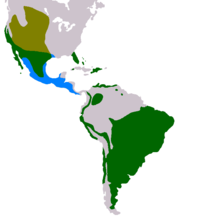| Burrowing owl | |
|---|---|

| |
| Brazilian burrowing owl A. c. grallaria Pantanal, Brazil | |
| Scientific classification | |
| Domain: | Eukaryota |
| Kingdom: | Animalia |
| Phylum: | Chordata |
| Class: | Aves |
| Order: | Strigiformes |
| Family: | Strigidae |
| Genus: | Athene |
| Species: | A. cunicularia
|
| Binomial name | |
| Athene cunicularia (Molina, 1782)
| |
| Subspecies | |
|
About 20 living, see text | |

| |
| Range of A. cunicularia Summer breeding range Winter non-breeding range Resident breeding range
| |
| Synonyms | |
|
Strix cunicularia Molina, 1782 | |
The burrowing owl (Athene cunicularia), also called the shoco, is a small, long-legged owl found throughout open landscapes of North and South America. Burrowing owls can be found in grasslands, rangelands, agricultural areas, deserts, or any other open, dry area with low vegetation.[3] They nest and roost in burrows, such as those excavated by prairie dogs (Cynomys spp.). Unlike most owls, burrowing owls are often active during the day, although they tend to avoid the midday heat. Like many other kinds of owls, though, burrowing owls do most of their hunting during dusk and dawn, when they can use their night vision and hearing to their advantage. Living in open grasslands as opposed to forests, the burrowing owl has developed longer legs that enable it to sprint, as well as fly, when hunting.
- ^ BirdLife International (2016). "Athene cunicularia". IUCN Red List of Threatened Species. 2016: e.T22689353A93227732. doi:10.2305/IUCN.UK.2016-3.RLTS.T22689353A93227732.en. Retrieved 30 October 2022.
- ^ "Appendices | CITES". cites.org. Retrieved 2022-01-14.
- ^ Cite error: The named reference
lewis2005was invoked but never defined (see the help page).
